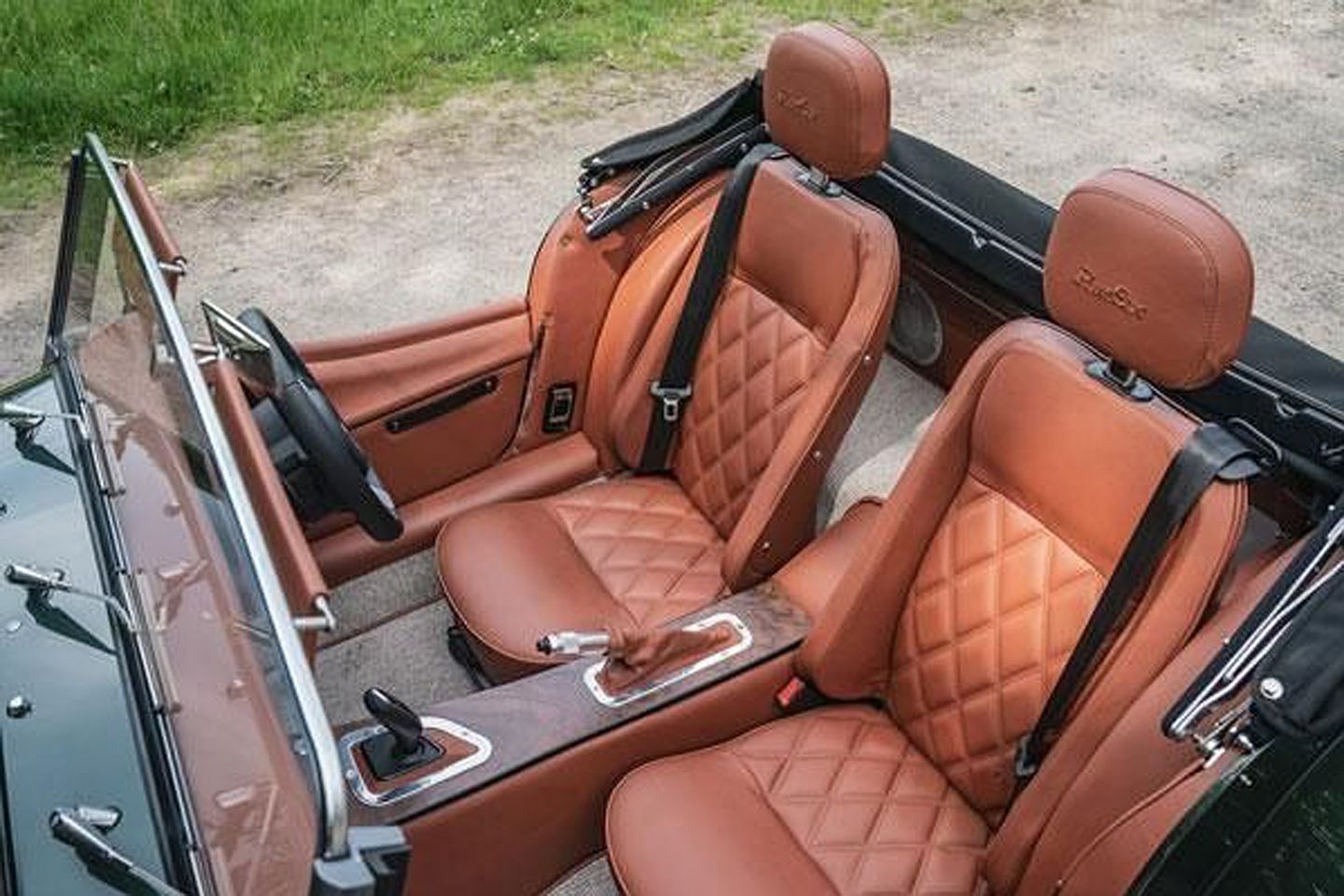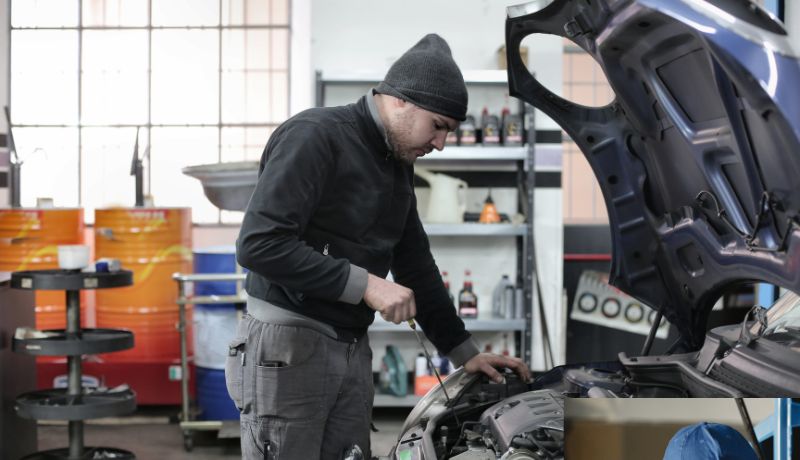Key considerations
- Available for £52,000
- 3.0-litre inline-six petrol turbo, rear-wheel drive
- A fine mix of vintage looks and modern performance
- CX chassis has greatly improved handling and comfort
- Still far from perfect but that’s all part of the appeal
- Depreciation is now a thing for Morgans, making used ones more affordable
Morgans quite literally need no introduction, so we’re not going to get into the rich history of these cars here. Instead, this buying guide is going to zone in on a ‘modern’ Morgan that went on sale in 2019 and that you can still order as a new car in 2024 – the Plus Six, Morgan’s first turbocharged car.
Replacing a line of 4.8 litre V8-powered Plus 8s, and the first all-new Morgan since the 2001 Aero 8, the Plus Six was built on Morgan’s then-new glued-aluminium CX Generation platform. Although it still incorporated an ash frame, the CX chassis had double the torsional rigidity of the previous generation cars and the structure’s weight was reduced by 100kg – a win-win. Overall weight of the Plus Six was well under 1,200kg (Morgan was claiming 1,075kg in 2019) so strong performance was very much guaranteed with the choice of powerplant, BMW’s 335hp twin-scroll turbocharged 3.0-litre inline six that we’d already seen in cars like the M140i and Z4 and the Toyota Supra. That speed guarantee was there despite the only gearbox on offer being the well-established, competent but not blindingly fast ZF 8HP 8-speed torque converter automatic.
The Plus Six was quite a bit shorter than any Aero 8 derivative, adding wieldiness, but there was no penalty on cabin space. Taller road testers who had always had to have Morgan seats in the fully back position, and who even then rarely managed to get in without banging their knee, were pleasantly surprised by the amount of room they had in the Six, aided by a wheel that adjusted for both reach and angle.
There was more to the Plus Six experience than big performance and decent cabin space. You also got ‘real car’ stuff like air conditioning, automatic lights, seatbelt warning bongs and even remote locking via the keyfob. Eeeh, what will they think of next?

The answer to that, in the January 2023 facelift at any rate, was an extra helping of chassis, safety and cosmetic upgrades, all done with at least one eye on the US market that was due to open up to Morgan that year via the low Volume Motor Vehicle Manufacturers Act. For obvious reasons, Morgan facelifts never look all that different to the car that’s being facelifted, but the underskin changes wrought to the Plus Six for ‘23 certainly fell into the ‘major’ category as far as the driving experience went.
The addition of electronic stability control was perhaps the most significant change. Prior to the inclusion of ESC, the provision of anti-lock braking was about as modern as it got in terms of Morgan dynamic safety aids. Hair-shirt traditionalists questioned the validity of stability control in a Morgan but it seemed like a good idea to anyone who had experienced the snap oversteer that the BMW engine could provoke in earlier non-ESC cars. This tendency had caught out more than one Plus Six owner, leading to a hike in insurance premiums for the model. Conventional braking was also changed in the ’23 refresh in the form of new AP Racing systems, and there were new suspension dampers and bushes too.
When it was launched in 2019 a basic Plus Six was priced at just under £78,000. Today, in October 2024, a new Plus Six will cost you £93,603 on the road. That’s for a basic car, but of course there’s no such thing as a basic Plus Six because every first buyer will be dipping into the extensive (and not inexpensive) options list. Example costs include £1,700 for soft grain leather, £600 for different carpets, £3k for an 8-speaker Sennheiser audio system, £3,655 for 19-inch wheels, £2k for special metallic paints, £4k for pearl paint, an £1,800 surcharge for two-tone, £95 for a Union flag bonnet badge, and so on.
Realistically, a new Plus Six is going to be approaching (or surpassing) six figures – the 2024 press car was nearly £110k – so it’s heartening to know that you can cut those costs in half by opting for a pre-owned car with around 10,000 miles on the clock. That’s assuming you can find a car specced to your taste, of course. It shouldn’t be too difficult as there really aren’t that many absolute duds out there. It’s hard to make such a classic design look bad.
SPECIFICATION – MORGAN PLUS 6 (2019-on)
Engine: 2,998cc turbocharged inline six 24v petrol
Transmission: 8-speed auto, rear-wheel drive
Power (hp): 335@5,000-6,500rpm
Torque (lb ft): 369@1,600-4,500rpm
0-62mph (secs): 4.2
Top speed (mph): 166
Weight (kg): 1,160
MPG (official combined): 35.8
CO2 (g/km): 180 (WLTP)
Wheels (in): 8.5 x 18 (f), 8.5 x 19 (r)
Tyres: 225/40 (f), 245/40 (r)
On sale: 2019 – on
Price new (2019): £78,000 (£90,000 for First Editions)
Price now (used): from £52,000
Note for reference: car weight and power data is hard to pin down with absolute certainty. For consistency, we use the same source for all our guides. We hope the data we use is right more often than it’s wrong. Our advice is to treat it as relative rather than definitive.
ENGINE & GEARBOX
BMW’s direct injection, double-VANOS, Valvetronic B58 straight-six engine had been around for four years or so when Morgan started slotting it into its Plus Six. Its twin-scroll turbocharger had an air-to-liquid intercooler Morgan put their stamp on everything by doing some in-house calibration. You could spec an active (and switchable) sports exhaust with silver or black tailpipes. The cost of that in 2024 is £2,340, but it was worth it to anyone who put a value on noise because the standard pipe was only marginally more exciting than an NHS waiting room.
BMW gave the B58 motor a bunch of improvements in 2018, a year before the Six was launched, and more again in 2022, including the addition of port injection. The B58 was well-liked in BMW tuning circles. It did get a bit of a reputation for issues with VANOS solenoid O-rings, leaky valve cover gaskets, crumbly oil filters and small coolant losses but overall it’s been a highly rated unit.
There have been issues with Plus Six (and Plus Four) radiators failing, in some cases on multiple occasions and sometimes in very short order, one after another. Theories abound as to why this happened, from a malfunction in the ECU that controlled the coolant flow to imperfect filling at the factory causing hot spots and cavitation and a vibration that could crack the radiator. A coolant swirlpot modification was put out by Morgan but that didn’t always resolve the issue.
Although there was a manual option for ‘donor’ B58-powered BMWs there was no money in Morgan’s budget to give customers a choice of two gearboxes, i.e. auto and manual. After examining their worldwide owner demographic they opted for the dependable ZF 8HP torque converter transmission with sport, sport+ and manual shift modes as well as full auto. It was a pity that Morgan couldn’t find the money for something a bit less 21st century than BMW’s gear selector, or for something a bit classier than the slightly tacky (in the Morgan’s naturalistic cabin environment anyway) wheel paddles which, rumour has it, came from Citroen.

If you weren’t concerned by any of that you would find that the ZF trans did the job as well in the Plus Six as it did in any BMW. It wasn’t perfect: left in full auto mode it would drop into the highest gear that the engine could handle, while in Sport+ mode it did the opposite, keeping the box in the lowest gear possible. Sport mode was the Goldilocks choice.
Boot it in that or in manual mode and you would never feel the need for more acceleration. The claimed 0-62mph time of 4.2 seconds might not sound all that special in our modern age but it felt positively gigglesome in a car that looked so old-school, especially when the roof was down, which it usually would be. If you really felt shortchanged on power Litchfield would do you a £720 remap that will take it to 405hp/380lb ft, with a 120lb ft uplift over standard at 2,800rpm.
The Plus Six petrol tank wasn’t large at a smidge over 10 gallons but even if you were relentlessly hooning along it would deliver 220 miles on a fill, more than enough for the majority of owners. Gentler cruising extended the range to over 350 miles.
As of October 2024 servicing at the works in Malvern cost £90 for a health check, £562 for an interim and £858 for a full, based on an alternating annual/10k mile schedule. The warranty of 3 years/36,000 miles was extendable for an extra £1,445 to 4 years/48,000 miles, so quite a few used Plus Sixes will still be covered by the factory. (All prices include VAT).

CHASSIS
Passengers climbing excitedly into traditional Morgans for a joyride would often get out wondering a) about the integrity of their fillings and b) why anyone would spend so much money on a car that shook and rattled like a fairground Waltzer carriage. Both were reasonable criticisms when applied to earlier Morgans, but life was different in a Plus Six. The difference on the road between it and earlier non-CX chassised Morgans was night and day. In terms of body control, you could still feel a degree of wobble in the Six over bumpy roads but not appreciably more than you’d experience in many other open-top cars. Grip from the Avon tyres was strong and the damper settings were fluid rather than Flintstone. There was less camber-following than drivers of older Morgans might have expected and the revision of the front/rear weight balance sharpened up the turn-in. In short, it was no longer necessary to accept the maxim that a Morgan’s vintage look had to go hand in hand with vintage dynamics.
Less pleasingly, there wasn’t much feedback from the electric power steering and, although it was light and quick, you often had to factor in extra moves for what might have been three-point turns in other cars. Large throttle applications would get the back end out in a somewhat uncouth fashion, but as mentioned in the overview there was much more predictability and less suddenness in the 2023 facelift cars that were equipped with stability control. The degree of intervention could be moderated through your choice of driving mode.
A popular suspension upgrade for Plus Sixes was the SSL (Suspension Supplies Ltd, Chesterfield) system. This consists of two pairs of tuned coil-overs with adjustable damping plus a new compliant progressive drop link for the quite stiff standard anti-roll bar to improve the ride over poor surfaces without losing roll control when cornering hard. Litchfield does a Nitron-based alternative which they say cures the problem of the suspension bottoming out on big bumps.
At 315mm front and 294mm rear, the brakes were easily up to the job of stopping the Plus Six, but they were also the subject of the only recall we could find for this model which dealt with premature degradation in the rubber seals in the brake master cylinder. The recall was issued in mid-2022. As mentioned in the overview, new AP Racing brakes were fitted on Plus Sixes from January 2023. In a separate issue, at least one owner reported being told by another motorist that their brake lights were permanently on. That turned out to be the brake pedal switch being out of adjustment.
BODYWORK
The old Plus 8 had big panel gaps built into its design to handle the amount of flex in the chassis but the Plus Six didn’t need them. Even so, some of the (probably few) owners who drove in the rain found that the doors still weren’t 100 per cent effective at keeping water out. One owner got around this by velcroing foam rubber around the door edges. He found that adding silicon to the gaps around the edge of the windscreen wasn’t a bad idea either.
The hood fastening mechanism remained resolutely vintage with poppers and latches that demanded commitment. You had to be careful with some of the self-locking Tenax fasteners which could snap under load if you didn’t unclip them at the right point in the lowering or raising process. A carbon fibre hard top was available. We weren’t able to discover the cost of that but it will be more than a tenner.
For extra cargo capacity, you could get a luggage rack and a leather suitcase to go on it. Go for black in both cases and the total bill would be around £2,060. There have been quite a few instances of Morgan rack mounts breaking though. There have also been problems in trying to undo the fuel caps on CX Morgans. Morgan tracked that down to a sharp corner of the plastic inner part that needed trimming off. Any dealer will do that job for you on an FOC basis.
INTERIOR
One potential advantage of building demonstrably ‘old’ cars like Morgans is that you can go in for a level of finishing that would have quality inspectors at other manufacturers going into a dead faint. Even later Morgans like the Plus Six went in for this ‘hand-crafted’ look. In fairness, dangly wiring and shonky fasteners weren’t in clear view unless you had to grovel about in the footwells for something you’d dropped, but after that you’d probably try to be more careful with the contents of your pockets.
It was also useful to have good neck mobility if you wanted to keep track of the road speed and engine revs in a Plus Six, or indeed most Morgans since the year dot, because the instruments monitoring those functions were in the centre of the dash, or as far away from the driver as possible in the case of the speedo. The info you were given in front of your face was the status of the coolant and fuel.
The printed circuit board controlling all the analogue dials has failed in some cars. That’s not a new thing for Morgans. Again it would seem that the factory has done a good job in their response to affected Plus Six owners.

Underneath you was a narrow-looking but actually quite comfy seat, heated in Comfort Plus spec. From there you had a fine view along the evocative bonnet past the Morgan trademark of three titchy screen wipers – not all of which would necessarily remain attached to the vehicle over its entire lifespan. Even if they did it wasn’t much of a loss as they didn’t work very well. We believe that Morgan has changed these wipers to a more efficient design in recent times but we’re not sure exactly when.
The 2023 refresh brought a glovebox for the first time on the Plus cars (both Four and Six). It contained a USB socket, another welcome whiff of modernity, but some owners expressed the view that it would have been better sited out in the open. There was also a new dash panel on the Six that you could have in silver, black or body colour, along with a bigger LCD display immediately ahead of the driver (which again might have detracted from the retro feel for some), and redesigned seats. New ‘bolt action’ door handles fabricated from stainless steel and saddle leather was another nice upgrade in the ’23-on cars, as were the new airbags in the wheel and behind the dash panel. It was easy to see the rationale of all this against the background of Morgan’s sortie into the US market.
Some owners found that the standard radio suffered from reduced signal strength when there was cargo on the rear shelf. The Sennheiser premium audio with Bluetooth input added a touch of sophistication but that wasn’t a cheap option (currently £3k). A lockable storage bin sitting behind the seats was £300.

PH VERDICT
It was perhaps inevitable that marketing copywriters would go into overdrive on Morgan after it was taken over by an investment fund at the same time as the release of the Plus Six in 2019. Massimo Fumarola, the new CEO, described the Plus line as ‘celebrating the essence of unconventional driving and ethical engineering… uniting timeless design and craftsmanship with the most exhilarating driving engagement… honouring those individuals who believe that motoring is not about status, but more about character, authenticity, and pleasure’.
Not sure how that definition differentiates Plus models from Super models, which you would have thought might aspire to the same airy-fairy goals. We think the Plus cars could be classified as more luxurious than the Supers but don’t quote us on that.
Leaving all this grumpiness aside let’s joyfully celebrate the fact that Morgans still exist. The mixing of old-fashioned style with modern engines like the B58 is always going to give some followers a sense of unease, but that’s how it’s always been with Morgans. The beauty of cars like the Plus Six is that the CX chassis is much more capable of handling power than, say, the old Rover V8-engined Plus 8.
Some Plus Six owners who have had issues with their cars have ventured the opinion that the revised parts fitted by Morgan seemed to be of a higher quality than the old ones that had failed. This is anecdotal stuff obviously, but if you choose to accept it then it could suggest to you that Morgan has the small-scale flexibility to respond in a timely and efficient fashion to problems that have been brought to their notice by owners. Which is a nice position to be in.
What you will always have on your side with any Morgan is a degree of exclusivity. In the past they were too exclusive, the company’s comically limited production facilities creating delivery times that at one point ran into several years. They were able to make a virtue out of necessity, stoking the FOMO allure while behind the scenes the accountants were quietly tearing their hair out.
Since the takeover, Morgan has predictably expanded. The numbers are still minuscule by global carmaking standards, but the market for Morgans is also minuscule so the supply/demand curve is much less wonky now. Not only are the long waiting times over, so is the absence of depreciation. Today’s Morgans are subject to the same market forces as most other cars. We’re not talking giveaway bargains here but even desirable Morgans like the Plus Six are much more attainable and available than they used to be.
The most affordable Plus Six on PH Classifieds at the time of going to press in mid-October 2024 was this 2019 car in Heather Green (a £1,600 option) with the 19-inch silver alloys (£2,900) and a few cabin tweaks. With 12,000-odd miles covered, it was up for £51,950.
Anyone remembering the orange Plus 8s from the 1970s might like this 10,000-miler in Orange Fury at a fiver short of £65k. For a different sort of retro look here’s a 2021 6,000-miler on standard 18-inch Speedster alloys with ivory paint and red leather. At the top of the used price heap, you’ll get £50 change from £100k for this delivery miles car in Porsche Etna Blue with a numbered grille, birch wood interior trim and Sennheiser audio.
Read more article: My new Colour


